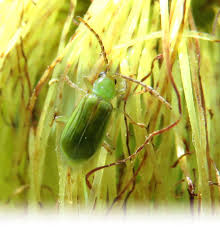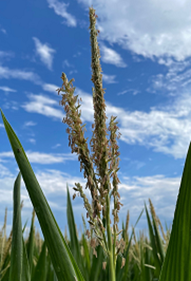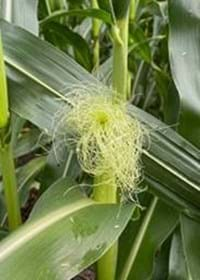Corn Crop Close to Tassel and Silking; Begin Monitoring for Corn Rootworm Beetles
BY Dairyland Seed Agronomy Team
MONITORING ADULT CORN ROOTWORM BEETLES
It’s that time of year to monitor corn rootworm (CRW) larval feeding and begin trapping adult beetles. Earlier this year we discussed monitoring for larval hatch and the subsequent feeding. Continue to do digs in those high priority situations.
The next step is to monitor adult beetles for areas of concern. The standard is to use yellow, unbaited sticky traps. This should begin, or have begun, around or just after tasseling. The exact procedure may vary a bit depending on the state and the professional making the recommendation. In general, see the bullet points below if you plan to monitor beetle populations.
As the season progresses, high populations of adults can be a cause of significant silk feeding as well. Silk feeding prior to or during pollination can result in poor kernel set. Typically, this isn’t a huge issue, but occasionally can be of concern.
A new management tool for corn rootworm, Dairyland Seed brand Vorceed™ Enlist® products will be available in the near future to assist us in the management and control of this costly pest. Speak with your local Dairyland Seed representative for addition technical information on how this product may work for you on your farm.
Begin monitoring mid-July. Rootworm larvae hatch when you see lightning bugs. Beetles emerge around silking time in mid-July.
- Check traps once per week
- 6 traps per field if you are monitoring a field
- Two rows of three traps
- 150’ from edge of field and 150’ between traps
- In corn-for-corn in 2023, use the plant itself attach the trap.
- In soybean-for-corn 2023, secure the trap to a plot post about 18” above the soybean canopy
- Continue trapping until the threshold has been obtained or until the dent stage of corn
- Threshold:
2 beetles per trap per day in corn
1.5 beetles per day in soybeans

UW-Madison IPM program, http://ipcm.wisc.edu
TASSEL AND SILKS OR BEYOND
For most of the Dairyland Seed territory, our corn crop is very close to Tasseling (VT) and Silking (R1 growth stage) which is the start of the reproductive (R) stage of the plant. Some areas may be slightly past that and at Blister (which is the R2 growth stage) when the kernels are white in color and the endosperm or the starch is clear in color.


In good growing conditions. silks can and do emerge from the cobs prior to tassel emergence. (As an aside, hybrids or genetic families that perform better in drier environment tend to shoot silks sooner than others). It is not unusual for silks to emerge a day or two prior to tassels and vice versa, where tassels and subsequent pollen from those tassels is out prior to the silks. In droughty conditions, corn plants can shoot the tassel out with the silks not emerging right away or when they do, the tassel has shed most of its pollen. This leads to poor pollination with few kernels on the ear and reduced yield.
Silks emerge from the husk with the silks from the base (butt) of the ear first. The ear tip silks are the last to emerge. In the first few days of silk emergence, silks can grow up to 1.5 inches per day, but will gradually slow down and will stop shortly after the pollen from the tassel is captured on the silk. Silks will continue to grow for 7 to 10 days or until pollen is detected. If you notice extremely longs silks on an ear, this can be a sign that the ear did not pollinate correctly. On the other hand, if you have silk being clipped by Japanese Beetle, Corn Rootworm Beetles or other insects, this will not allow enough pollen silking area to land on and start the fertilization process. Due to their high-water content, silks are very sensitive to moisture levels in the plant. Heavy morning dews or moisture prior to and during pollination keeps these silks healthy. Conversely, hot and dry with high winds is not good for silks.
Tassel emergence marks the end of vegetative grow. This means that within a day or two of the tassels emerging, the plant will have reached its total above and below ground growth. Tassels emerging also signifies that within a day or two we will start to see pollen falling from these tassels. Pollen normally sheds from the middle portion of the tassel first and will work its way up and down the tassel. This shedding normally takes place within 7 to 14 days.
Pollen, unlike silks, prefers hot and dry conditions. Typically, cool humid conditions delay the shedding of pollen from the tassel. Pollen is not shed during rain events or wet tassels. Most pollen shed takes place mainly during mid-morning hours with another shedding event taking place in late afternoon or early evening as temperatures cool. Pollen shed slows if temperatures exceed 86°F. Heat of 100°F or more can kill pollen.
However, as previously stated, pollen is shed from different parts of the tassel over a 7 to14 day timeframe. If, by chance, we have a few days where pollen shed is reduced or pollen is terminated due to temperatures, we should be able to shed enough pollen to hit the silks and fertilize the ovules which, when successful, turn into kernels. If the pollen is unsuccessful in catching on to the silks, and fertilization does not take place, this silk will stay attached to that ovule for a period of time, whereas the fertilized kernels will not have a silk attached.
If you have questions regarding this or other agronomic concerns, reach out to you Dairyland Seed DSM or Regional Agronomist.
SHOW YOUR #DSPRIDE WITH DAIRYLAND SEED FIELD SIGNS
Share your #DSPride by signing your great looking fields of corn, soybeans and alfalfa!
Contact your local rep or DSM for more details on getting your fields signed. Or, call the Dairyland Seed headquarters at 800-236-0163 and ask to speak with Stacy Hendricks, Cindy Flasch or Diana Siders.
CORTEVA TECHNOLOGY USE AGREEMENTS
All growers with orders for any Corteva Agriscience brand seed product, regardless of crop or trait (including non-GM products) need to have a signed Corteva Technology Use Agreement in place by August 26. Growers should sign the Corteva Technology Use Agreement electronically at www.agcelerate.com. Signing electronically is preferable, however, paper copies are available at www.traitstewardship.com.
 |
 |
 |
 |
 |
| Brian Weller Western Region 507.456.3034 |
Dan Ritter Central Region 219.863.0583 |
Branden Furseth Northern Region 608.513.4265 |
Mark Gibson Eastern Region 260.330.8968 |
Amanda Goffnett Eastern Region 989.400.3793 |
